How do women and men use their time - statistics
Data extracted in April 2019
Planned article update: October 2024
Highlights
Participation rate in household and family care, main activity, %, by gender (2008 to 2015)
The Harmonised European Time Use Survey statistics (HETUS) data shows that there are particular patterns of how women and men use their time: women are, on average, more involved in household and care activities than men. Women perform more food management, cleaning, ironing and laundry, while men are more involved in construction and gardening. While men and women participate both in childcare, it seems that women are relatively more involved in physical care, supervision and accompanying their children, while men seem to participate relatively more in teaching, playing and talking with their children.
This article focuses further on exploring the gender dimension in parallel (secondary) activities and unpaid work as main activity. Leisure activities like listening to the radio, watching TV or going on visits in parallel to other main activities are common among people and may contribute to their everyday balance. The data shows that women tend to perform more household and care activities as a secondary activity than men, hinting at a gender perspective of the multitasking phenomenon.
Full article
Overview
The Harmonised European Time Use Surveys (HETUS) are national surveys conducted on a voluntary basis in some EU and non-EU countries. There have been two HETUS waves by now, around 2000 and 2010; the third HETUS wave is planned for 2020. The data collected in HETUS gives information on how much time people spend doing various activities like paid and unpaid work, household and family care, leisure and social life or travel, and it can be used to study time use patterns in various policy fields in a cross-country perspective.[1]
This article makes an overview of the data from the HETUS 2010 wave. The data was collected between 2008 and 2015 in 18 European countries, 15 of which are EU Member States and 3 are non-EU countries (Norway, Serbia and Turkey). This article presents three types of indicators :
- Time spent on a given activity: this is the mean time spent per day on an activity by all individuals,
- Participation time on a given activity: this is the mean time spent on an activity by only those individuals who took part in the activity for at least 10 minutes a day, and
- Participation rate: this is the proportion of individuals who spent at least 10 minutes a day doing the activity among the whole population.

Source: Eurostat (tus_00age)
Figure 1 gives an overview of the time use pattern in the main activity [2] over 24 hours in the 18 countries where the HETUS wave 2 was conducted. The main findings show that people sleep between 8 h and almost 9 h a day, they spend between 4 h 30 min to 6 h on leisure and social life activities, and they carry out household and family care activities between 2 h 30 min and 3 h 30 min a day on average. Considering employment and related activities, the mean time spent daily is between 2 to 3 hours on average. Study-related activities occupy between 20 and 35 minutes of peoples' daily time on average.
However, it should be noted that the indicator of time spent is useful mostly for activities performed by all or nearly all individuals, which is the case for sleeping, eating and other personal care, and leisure, where participation rate is close to 100 %, and to some extent for household and family care (participation rate is between 72 % and 93 %).
Given that not all individuals are employed or participate in study activities [3] , it is more useful to look at the indicator of participation time in employment and study (i.e. only for those individuals who took part in the activity). Figure 2 presents this second indicator for employment and study, while Figure 3 presents the participation time in household and family care activities by gender.
Average time spent in employment is 6 h 30 min to 8 hours per day
Figure 2 shows that among those who participate in employment, the time spent on this activity is between 6 h 30 min to almost 8 hours per day in the 18 countries where HETUS wave 2 was carried out. Regarding study-related activities, the time spent is between 4 and slightly above 6 hours on average among those who participate in studying.
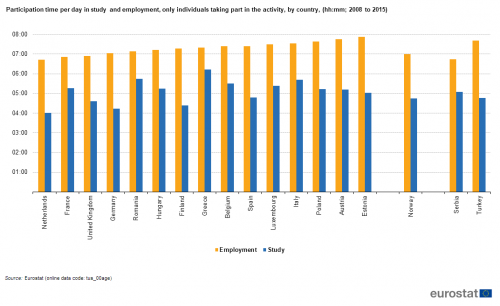
Source: Eurostat (tus_00age)
Women are more involved in household and family care activities
Figure 3 presents the time spent on household and family care as main activity among those who have been doing this activity for at least 10 minutes a day. Household and family care includes unpaid work done for one's own household. Paid activities are not included in this category (they are found under the category Employment), just as work done for another household is excluded. Some examples of household and family care activities include food management[4], household upkeep such as cleaning the dwelling, gardening, pet care, care for textiles, construction and repairs, shopping and services, household management, childcare, and caring for an adult household member.
As Figure 3 shows, the time spent on household and family care activities for the whole population varies between 3 and 4 hours on average across countries, whereas women are much more involved than men in all countries. The gender gap is the highest in Turkey (3 h 16 min more for women than for men), Italy (2 h and 47 min) and Greece (2 h and 21 min), and it is the lowest in Norway (47 min), the Netherlands (1 h and 2 min), Finland (1 h and 9 min), and France (1 h and 11 min).

Source: Eurostat (tus_00age)
Figures 4-8 show the HETUS participation rate in various activities. This participation rate in a given activity was defined as the proportion of individuals among the whole population who spent at least 10 minutes a day doing the activity.
Figure 4 shows the participation rate in household and family care activities by gender. The participation rate of women is higher than that of men in all countries, and it is also quite stable across countries - between 94 % and 98 %. The participation rate of men varies considerably across countries, being the lowest in Turkey (53 %), followed by Italy (70 %), Greece (72 %) and Spain (77 %), and it is the highest in Finland (93 %) and Norway (92 %).

Source: Eurostat (tus_00educ)
The HETUS data allows us to zoom in and see which particular household and family care activities are more common among men, and which are more common among women. Figures 5 to 8 show the participation rate in some of these household and family care activities for men and women.
Participation of women higher for cleaning, cooking, laundry, etc
Regarding typical household activities like cleaning the home, food management, ironing and laundry the participation rate of women is systematically higher than that of men (see Figures 5 and 6). Food management is the household activity done most by both men and women: participation rate of men in food management is between 20 % and 70 % on average, the highest found in Norway (70 %) and Finland (61 %). The participation rate of women is between 77 % and 91 % on average across countries, the highest found in Poland (91 %), Serbia (89 %) and Turkey (88 %).

Source: Eurostat (tus_00educ)
Not many people do ironing and laundry at least 10 minutes every day[5], but when done, it is predominantly done by women (see Figure 6). In 14 out of 18 European countries that conducted HETUS 2010, the participation rate of men in ironing is below 2 %, and in nine countries the participation rate of men doing laundry is below 3 %. Women are considerably more involved than men into these two household activities: the percentage varies between 8 % and 29 % on average for ironing, and between 14 % and close to 40 % for laundry across the countries.

Source: Eurostat (tus_00educ)
Shopping and services are very diverse activities (see Figure 7). Services can include both commercial/ administrative services and personal services. Examples of commercial or administrative services include visiting post office/ bank/ municipality authorities, etc., while personal services may include visiting a doctor/ barber's etc. for one's own care.
Equivalent involvement of men and women in shopping and services
Men and women are relatively equally involved in shopping and services, with a slight predominance of women. Participating in shopping and services among men, i.e. men doing these acitivities at least 10 minutes a day, is most common in Finland (51 %) and Norway (49 %) and least common in Turkey (23 %) and Greece (26 %). Participation in these activities among women is most common in Norway and Poland (57 % each), least common in Turkey (23 %) and Romania (32 %).

Source: Eurostat (tus_00educ)
Equivalent involvement of men and women in childcare but in different activities
Childcare (see Figure 8) is an activity performed by both men and women. It involves various activities such as supervision, playing, teaching, etc. which are performed to a different extent among men and women. Childcare involving physical care, supervision, accompanying the child, for example, is more common among women than among men: participation rate of men is between 6 % and 21 %, while that of women is between 14 % and 32 % on average across the countries. The countries with the highest male participation rate are Norway (21 %), Spain (17 %), and the Netherlands (16 %), while the countries with the highest female participation rate are Turkey (32 %), Poland and France (27 % each).
Men and women however participate almost on an equal basis in childcare activities such as teaching, reading, playing or talking with the child. The participation rate in these childcare activities is highest in Poland, Austria and Hungary for both men and women, ranging in these three countries between 15-16 % for men and 22 % - 24 % for women. The lowest participation rate is found in Romania: 7 % for men and 10 % for women.

Source: Eurostat (tus_00educ)
Construction mainly done by men, gardening by both genders
Construction and repairs as well as gardening are the activities where men seem to be on average more involved than women in many countries (see Figures 9 and 10). Construction and repairs include changes to the house, including construction of a new building (e.g. garage), extension, alteration, various repairs of the house, painting, repairing or maintaining equipment (e.g. furniture, household goods, etc.) and vehicle maintenance. Gardening and pet care include activities which are not connected to farming.
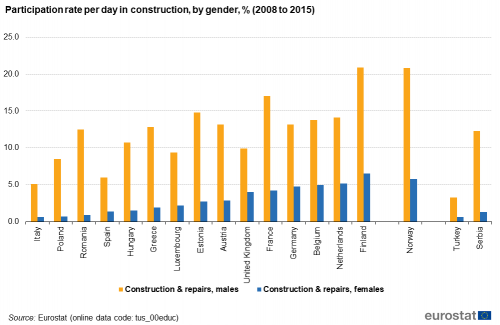
Source: Eurostat (tus_00educ)
In virtually all 18 countries that have done HETUS 2010, more men participate in construction activities than women. Up to 21 % of men perform construction and repair activities, while only up to slightly above 6 % of women on average participate in these activities. The highest participation for both men and women is found in Norway and Finland (21 % for men in each country and 6 % to 7 % for women respectively), and the lowest participation for both men and women is in Turkey (3 % for men and 0.6 % for women) and Italy (5 % for men and less than 1 % for women).

Source: Eurostat (tus_00educ)
Participation in gardening (growing vegetables, flowers, etc.) varies between 4 % and 16 % for men on average and between 3 % and 24 % for women across countries. Apart from 7 countries (Austria, Estonia, Finland, Germany, Poland, Norway, and Turkey), men participate more than women in gardening. The highest participation of men is found in Hungary (16 %), Austria, Greece, Belgium and Germany (around 14 % in each). Austria has the highest female participation in gardening (24 %), followed by Germany (16 %).
Multitasking: two activities at the same time
Given the dynamic pace of life nowadays, many people are confronted with the challenge of performing several activities at the same time, i.e. multitasking. For example, cooking/ cleaning and supervising a child or an elderly person. HETUS provides evidence on this by collecting data on secondary (parallel) activities, that is, if a respondent was doing more than one thing at the same time: "What else were you doing?" The decision of which activity is to be classified as "main" and which as "secondary" is left to the discretion of the respondent[6].
Figures 11a-11c show data on the average time spent on doing particular secondary activities only among those who have been involved for at least 10 minutes in the respective secondary activity (i.e. participation time).
The total participation time spent on doing secondary activities varies between 2 h 46 min (Luxembourg) to 7 h (Hungary) across the countries. The most common secondary activities people carry out are listening to the radio and music (between 1 h 30 min and 2 h 30 min per day), watching TV (between 1 h and 1 h 50 min), socialising with family (between 30 min and 2 h daily), and visiting and feasts[7] (between 50 min and 2 h 50 min daily). Visits and feasts as secondary activities are most common in Spain (2 h 47 min) and Greece (2 h 12 min), and least common in Hungary (50 min), Austria (51 min) and Norway (56 min).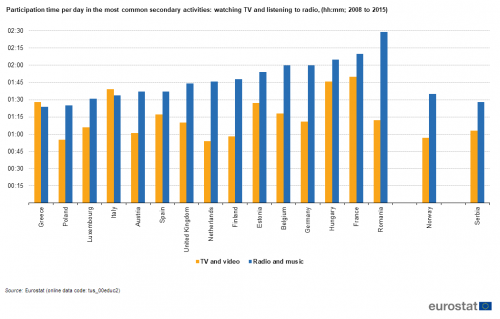
Source: Eurostat (tus_00educ2)

Source: Eurostat (tus_00educ2)
Childcare and family care often done as secondary activities
While listening to radio/ music, socialising with family or visiting/ feasts belong to the so-called leisure activities, doing household work or family care, including childcare, in parallel with the main activity can be quite demanding for the person, and can put her/ him under stress, not least because these activities require considerable attention and concentration.
In addition to being done as main activities, childcare and household activities are often done as secondary activities, and for a considerable time. For the total population, childcare as secondary activity takes up between 50 min and 1 h 45 min on average per day. The lowest time is found in Luxembourg and the Netherlands (50 min), and, on the opposite, the highest in Germany (1 h 45 min), Romania and Estonia (1 h 30 min).
Household and family care (excluding childcare) as secondary activity takes up between 35 min (Italy, Poland, the Netherlands, Finland) to 1 h 17 min (Spain) on average daily, for the total population.
Figures 11c and 11d present the participation time in childcare and household activities by gender. The two figures reveal that the time spent on childcare, on the one hand, and on household and family care, on the other, is higher for women in all countries. The gender gap for childcare is above 30 min on average per day in countries like Germany, Finland, Hungary, Romania and Estonia. The gender gap for household and family care is lower, slightly above 20 min on average per day in Serbia, Hungary, Poland and Germany.
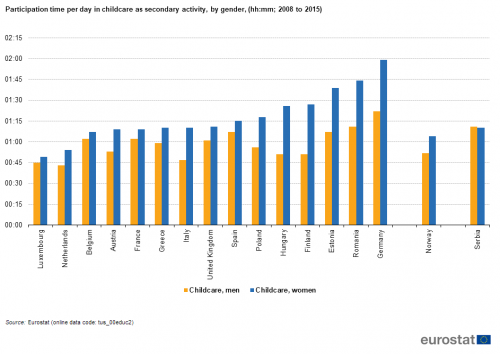
Source: Eurostat (tus_00educ2)
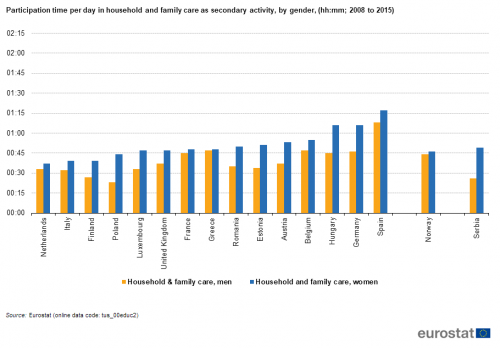
' 'Source: Eurostat (tus_00educ2)
Women spend more time on productive unpaid activities
HETUS provides data also on unpaid work. When activities such as food preparation, cleaning dwelling, laundry, ironing, gardening, construction and repairs, shopping and services, childcare, house management are done as main or secondary activities without pay for the own household or for another household, they constitute unpaid work[8]. Figure 12 presents data on time spent on unpaid work (as main activity) among those who have been doing it for at least 10 minutes (i.e. participation time).
The average participation time spent on productive forms of unpaid work as a main activity varies across countries between 3 h15 min(the Netherlands, Luxembourg, the United Kingdom) to above 4 h in Turkey (4 h 5 min), Serbia and Hungary (4 h 7 min), Romania (4 h 10 min) and Italy (4 h 15 min). Figure 12 shows that women spend more time on unpaid productive activities than men in all countries that have conducted the HETUS 2010 wave. In Turkey the gender gap is 3 h 30 min per day and in Italy it is 3 hours.
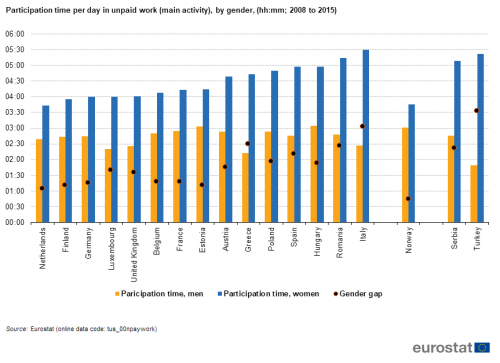
Source: Eurostat (tus_00npaywork)
Source data for tables and graphs
Data sources
The data used in this section are collected via voluntary national time use surveys performed in selected European countries at least every ten years. The reference population of the survey is all private households and their current members living on the national territory at the time of the data collection; persons living in collective households and in institutions are generally excluded from the target population. As a voluntary survey, HETUS contained data from 15 European countries in wave 2000, and data from 18 European countries in wave 2010; therefore no EU-28 aggregates could be calculated.
Context
Currently, HETUS provides rich comparable data on time use patterns in various fields of policy interest: work life balance, paid and unpaid work, gender issues, parallel activities, leisure time, transport and commuting, etc. Researchers have used time diary methods for analysing people’s behaviour since the mid-1920s in many countries. During these early efforts, a spirit of co-operation developed among people performing time use research.
Co-operative efforts in the time use field between scholars from many countries led to the creation of the so-called Working Group on Time Budgets and Social Activities during the International Sociological Association meeting in Varna, Bulgaria in 1970. This working group voted to transform itself into the International Association for Time Use Research (IATUR) during its 1988 meeting in Hungary. IATUR now maintains a web site of on-going activities in the time use field as well as co-ordinating time use conferences and research meetings.
The spirit of multi-national and multi-agency co-operation at a European level has continued till present under the form of an informal Gentlemen's agreement. Eurostat has co-ordinated the development of Harmonised European Time Use Survey (HETUS) data collection guidelines, which were piloted in 20 countries between 1996 and 1998, and have influenced time use data collection in 21 countries between 1999 and 2003, and in 18 European countries between 2008 and 2015. The next wave is planned for 2020 under the updated HETUS 2018 Guidelines[9] . From 2030, HETUS will be conducted under the Common Framework regulation for European statistics relating to persons and household.
The United Nations have coordinated international efforts for harmonisation of time use activity categories across countries around the world. The United Nations have developed the ICATUS classification of time use activities to allow both developed and developing countries to collect comparable time use data, which would allow country-wide assessment of various dimensions of quality of life, including work-life balance, general well-being, unpaid work, social life, etc. The latest ICATUS classification is from 2016.
Direct access to
See also
- Gender statistics
- SDG 4 - Quality education
- SDG 5 - Gender equality
- Culture statistics - cultural participation
- Statistics on sport participation
- Living conditions in Europe - work intensity
- Participation of young people in education and the labour market
- SDG 3 - Good Health and well-being
- Mental well-being and social support statistics
- Quality of life indicators - natural and living environment
Publications
Methodology
External links
- Work of the Eurostat innovation task forces for HBS and TUS
- US Department of Labor - Bureau of Labor Statistics, American Time Use Survey
- Hungarian Central Statistical Office, Animation of European Time Use Data
- Australian Bureau of Statistics: How Australians use their time (selected results from the 2006 Time Use Survey)
- International Association for Time Use Research - IATUR: worldwide forum for people interested in any aspect of time use to meet each other and share ideas
- United Nations Statistics Division: Allocation of time and time-use and International Classification of Activities for Time-Use Statistics (ICATUS 2016)
- University College London (UCL) Centre for Time Use Research CTUR and Multinational Time Use Study (MTUS)
Notes
- ↑ Published in the Eurostat database: https://ec.europa.eu/eurostat/data/database
- ↑ Respondents are asked to write down what they did during every 10-minute slot. However, given that not more than one activity can be coded in one 10-minute slot, when two activities are done simultaneously, the respondent has to decide which one he would code as "main" and which one as "secondary" activity. Data on parallel activities are collected via the question "What else were you doing?". There are some guidelines proposed in the HETUS 2018 Guidelines (Chapter 4.3.2/ Coding of multiple main activities) as to how to determine which activity is a main or a secondary one.
- ↑ In fact, according to HETUS data, the participation rate varies between 29 % and 43 % for employment, and between 6 % and 11 % for studying on average in the countries that have conducted the HETUS 2010 wave.
- ↑ Food management includes all activities in connection with food preparation, baking, preserving, freezing and canning (e.g. cooking, heating up food, cleaning berries, boiling jam or fruit-syrup, preparing food for later). It also includes setting the table and serving.
- ↑ Laundry includes hand wash, loading and unloading washing machine, hanging out; Ironing includes also folding and putting things in the wardrobe. Doing ironing and laundry are not activities that are done every day of the week; as the data for HETUS are collected during (only) one randomly selected weekday (out of five) and one weekend day (out of two), the “real” participation rate in these activities is underestimated.
- ↑ When two activities are done in one 10-minute slot, the respondent has to decide which one he would code as "main" and which one as "secondary" activity. Section 4.3.2 of the HETUS 2018 Guidelines lists some guidance and examples as to how to determine which activity is main and which is a secondary one. For example, if one activity is likely to be a consequence of the other, then it is to be coded as a secondary activity (e.g. talking with family while having supper: talking with family is considered as secondary activity, and having supper as main). Which activity lasts longer can be a consideration to take into account, but it should be weighted against the importance of the activity for the respondent or the level of concentration required.
- ↑ Visiting includes socialising with friends and relatives at home or in their home; Feasts include celebrations like weddings, parties, anniversaries, etc. with family members, relatives or friends at or outside home.
- ↑ More precisely, unpaid work is defined to include all activities in section 3 (Household and family care) and section 4 (411, 421 - 429) of the 2008 Guidelines when done as main activity without pay, as well as section 3 except childcare ( 38) and section 4 (411, 421 - 429) when done as secondary activity without pay.
- ↑ https://ec.europa.eu/eurostat/documents/3859598/9710775/KS-GQ-19-003-EN-N.pdf/